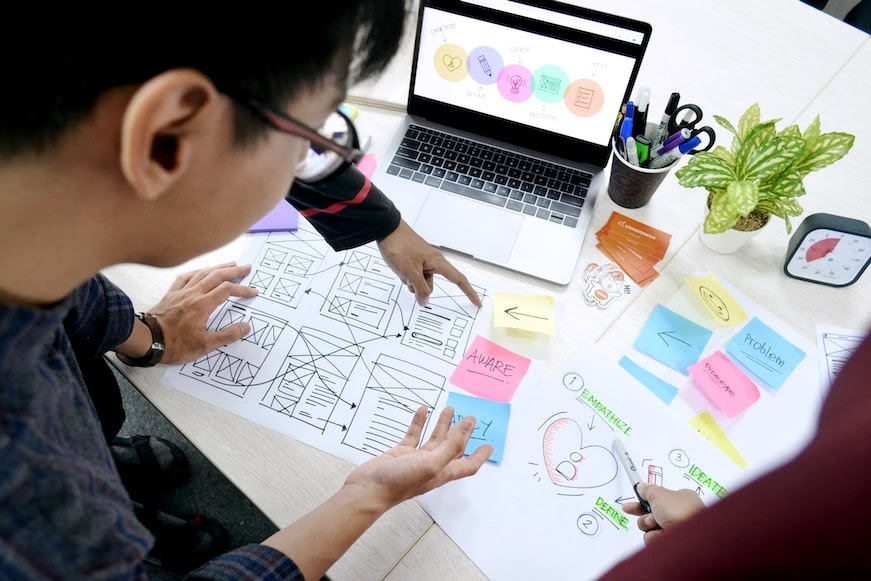In this blog post, we will explore the potential return on investment of UX design. We will define ROI and explain its importance in business decision-making. We will also discuss the different ways that UX design can contribute to ROI and provide examples of companies that have successfully achieved ROI through UX design.
A Brief Overview of UX Design
UX design creates user-friendly digital products through understanding user needs, generating ideas, prototyping, testing, and iterating for a positive user experience.
The importance of UX design cannot be overstated. It can have a significant impact on business success, customer satisfaction, and brand loyalty. When done right, UX design can improve engagement and drive revenue growth.
Related – What is UX Design and Why is it important?
Understanding the Value of UX Design
The potential return on investment of UX design can be ample. By creating a positive user experience, businesses can improve customer satisfaction and loyalty, leading to increased engagement and revenue growth. Additionally, UX design can reduce costs by streamlining processes and reducing support requests.
UX design can help improve customer satisfaction by providing a seamless and enjoyable experience for users. This leads to increased engagement and loyalty, as users are more likely to return to a product or service that is easy to use and meets their needs.
- One example of a company that prioritizes UX design is Apple. Apple is known for its sleek and intuitive products, such as the iPhone and MacBook, which are designed with the user in mind. By focusing on UX design, Apple has built a loyal customer base that continues to purchase its products year after year.
- Another example is Airbnb, which has revolutionized the travel industry through its innovative UX design.
By prioritizing UX design, Airbnb has successfully transformed into a multi-billion dollar company and disrupted the traditional hotel industry. In addition, the company offers a user-friendly platform that enables users to effortlessly discover and book unique accommodations worldwide.
Related – UI UX Design Process: A Pathway that Experts Follow
The Potential Return on Investment of UX Design
ROI, commonly known as return on investment, serves as a key metric to gauge the profitability of an investment. Undoubtedly, it holds significant importance in business decision-making, enabling businesses to assess the potential financial advantages of an investment and make well-informed resource allocation decisions.
Different Ways that UX Design Can Contribute to ROI
Measuring the potential return on investment of UX design can be challenging, as it involves quantifying the financial impact of intangible benefits, such as improved user satisfaction and loyalty. However, there are several ways to measure the ROI of UX design:
1. Revenue Growth
A positive user experience can lead to increased engagement and revenue growth. By tracking metrics such as conversion rates and customer lifetime value, businesses can evaluate the financial impact of UX design.
2. Improved Efficiency
UX design can improve efficiency by reducing the time and effort required for users to complete tasks. By tracking metrics such as task completion times and user satisfaction, businesses can evaluate the efficiency gains of UX design.
3. Cost Savings
UX design plays a pivotal role in cost reduction by streamlining processes and minimizing support requests. To evaluate the cost savings brought about by UX design, businesses can track metrics such as call center volume and support ticket resolution times.
Related – Exploring the Social Network Startup Costs
Examples of companies that have successfully achieved ROI through UX design include:
- IBM: By investing in UX design, IBM was able to reduce development time by 33% and improve customer satisfaction by 50%.
- Intuit: By redesigning its QuickBooks product with a focus on UX design, Intuit was able to increase revenue by 30% and reduce support calls by 25%.
- Slack: By providing a seamless user experience, Slack was able to achieve a $7.1 billion valuation just two years after launch.
Factors That Influence ROI in UX Design

Several factors can have an impact on the potential return on investment of UX design. Consequently, understanding and optimizing these factors can greatly enhance the ROI of UX design. Noteworthy factors that influence ROI in UX design include:
1. Level of investment
The level of investment in UX design can significantly impact the ROI. Investing more in UX design can lead to a better user experience, which can result in increased revenue and customer loyalty. However, it is important to balance the investment with the potential return.
2. User Engagement
User engagement is a critical factor in the success of UX design. High user engagement can result in increased revenue, while low user engagement can result in decreased revenue and negative ROI. Therefore, it is essential to understand user needs and preferences and create a user experience that aligns with them.
3. Business Goals
Business goals play a significant role in determining the ROI of UX design. UX design can help achieve a variety of business goals, such as increasing revenue, reducing costs, and improving customer satisfaction. Therefore, it is essential to align UX design with business goals and measure the impact on those goals.
Related – From Awareness to Loyalty: Understanding the User Journey in UX Design
How to optimize for maximizing ROI in UX design
To optimize these factors and maximize ROI in UX design, businesses can take several steps, such as:
- Conducting user research: User research is critical to understanding user needs and preferences. By conducting user research, businesses can create a user experience that aligns with user needs and preferences, resulting in higher user engagement and increased revenue.
- Investing in UX design: Investing in UX design can significantly impact the ROI. By investing more in UX design, businesses can create a better user experience, resulting in increased revenue and customer loyalty.
- Measuring the impact: Measuring the impact of UX design is critical to optimizing the ROI. By measuring the impact on business goals, such as revenue, costs, and customer satisfaction, businesses can identify areas for improvement and optimize the UX design to achieve maximum ROI.
Optimizing factors like investment, user engagement, and business goals greatly impact UX design ROI. By understanding and optimizing these factors, businesses can maximize ROI and achieve their goals.
Case Studies: Examples of Return on Investment of UX Design
Case studies can provide concrete examples of how UX design can contribute to ROI. Here are a few examples:
1. Airbnb: UX Design for Improved User Engagement
Airbnb is an online marketplace that connects travelers with hosts who offer short-term lodging.
Airbnb’s UX design team conducted extensive user research to identify pain points and opportunities for improvement. They then implemented several changes, such as simplifying the search process and making it easier for hosts to create listings.
The result? Improved user engagement, with users spending more time on the platform and booking more frequently.
According to Nielsen Norman Group’s case study, UX improvements led to a 30% increase in bookings and a 10% increase in revenue per booking.
2. IBM: UX Design for Improved Efficiency
IBM, a multinational technology company with diverse products and services, acknowledged that its complex software offerings were generating confusion and frustration among users. Consequently, this resulted in reduced efficiency and productivity.
To address this, IBM invested in UX design to simplify its products and improve the user experience. The company used design thinking methodologies to understand user needs and pain points, and then iteratively tested and refined its designs.
The result? Improved efficiency and productivity for IBM’s users, with a reported 60% reduction in support calls and a 4x increase in customer satisfaction.
3. Intuit: UX Design for Improved Customer Satisfaction
Intuit is a financial software company that offers products such as QuickBooks and TurboTax. The company recognized that its users often found its products confusing and difficult to use, leading to high levels of frustration and churn.
To address this, Intuit invested in UX design to improve the user experience and increase customer satisfaction. The company conducted extensive user research and implemented a number of changes, such as simplifying the product interface and improving the onboarding process.
The result? Consequently, businesses experienced increased customer satisfaction and loyalty, with a notable 32% decrease in customer churn and an impressive 211% increase in user conversion rates. These case studies vividly illustrate how UX design can contribute to ROI through various means, such as boosting revenue, achieving cost savings, and enhancing efficiency and customer satisfaction.
Best Practices for Achieving Potential Return On Investment of UX Design
To achieve a potential return on investment in UX design, there are several best practices that businesses and design teams should follow:
- Test and Iterate: Continuously testing and iterating on your designs is essential for achieving ROI in UX design. This allows you to identify and address issues early on in the design process, resulting in a better user experience and fewer costly redesigns down the line.
- Prioritize Design Consistency: Maintaining consistency in your design elements and interactions can improve user efficiency, reduce confusion, and ultimately increase user satisfaction. Creating a style guide or design system can help ensure consistency across all touchpoints.
- Collaborate Effectively: Collaboration between designers, developers, and stakeholders is key to achieving ROI in UX design. This involves establishing clear communication channels, defining roles and responsibilities, and working towards shared goals.
- Measure and Analyze: To understand the impact of your UX design efforts on ROI, it’s important to establish metrics and regularly measure and analyze user behavior and business outcomes. This data can help you identify areas for improvement and make data-driven design decisions.
By following these best practices, businesses can create user-centered designs that improve customer satisfaction, increase revenue, and ultimately achieve ROI in UX design.
Conclusion
Investing in UX design can yield a significant return on investment for businesses. Moreover, by creating a user-friendly and enjoyable experience, businesses can enhance customer satisfaction, loyalty, and revenue. Additionally, UX design helps identify pain points and areas for improvement, leading to a streamlined and efficient user experience.
Additionally, a well-designed product or service can differentiate a business from its competitors and improve its reputation in the market. While investing in UX design may require an upfront cost, the long-term benefits make it a worthwhile investment for businesses looking to improve their bottom line. Overall, businesses that prioritize UX design can expect to see a positive return on investment and a more successful product or service.









